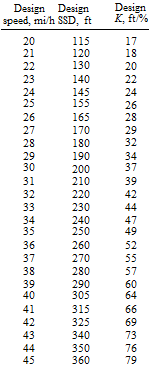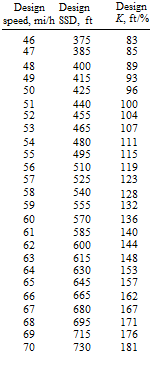Coordination of Horizontal and Vertical Alignments
When designing new roadway projects, the following items should be considered to
coordinate the horizontal and vertical alignments:
• Curvature and tangent sections should be properly balanced. Normally, horizontal curves will be longer than vertical curves.
• It is generally more pleasing to the driver when vertical curvature can be superimposed on horizontal curvature. In other words, the PIs (points of intersection) of both the vertical and horizontal curves should be near the same station or location.
• Sharp horizontal curves should not be introduced at or near the top of a pronounced crest vertical curve or at or near the low point of a pronounced sag vertical
curve.
TABLE 2.19 Stopping Sight Distance for Sag Vertical Curves at Design Speeds from 20 to 70 mi/h (32 to 113 km/h)
 |
 |
![]()
 |
 |
Height of headlight = 2.00 ft Upward light beam divergence = 1°00′
• On two-lane roadways, long tangent sections (horizontal and vertical) are desirable to provide adequate passing sections.
• Horizontal and vertical curves should be as flat as possible at intersections.
• On divided highways, the use of variable median widths and separate horizontal and vertical alignments should be considered.
• In urban areas, horizontal and vertical alignments should be designed to minimize nuisance factors. These might include directional adjustment to increase buffer zones and depressed roadways to decrease noise.
• Horizontal and vertical alignments may often be adjusted to enhance views of scenic areas.






Leave a reply